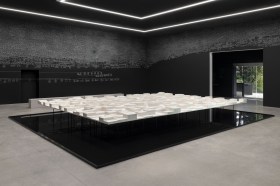I admit that I went expecting to see quite a different set of images from those exhibited in this solo show in Plockton. I can only blame myself for this because I hadn’t taken the time to look at either the gallery or Claire’s own site on the web beforehand.
Think of St Kilda and you probably picture precipitous, needle-sharp sea stacks emerging from a boiling North Atlantic and the Movietone black and white films of crazy islanders abseiling down cliffs to raid the nests of gannets and puffins. Claire Harkess RSW, from her visits there over the course of about three years, has responded to this extraordinary place by putting together a beautiful collection of a hundred watercolours and ink drawings which currently grace the walls of this delightful gallery.
The works depict landscapes/seascapes and birdlife. The raw edge and drama that I was expecting in the landscapes is mostly tempered by a soft focus. She concentrates on key details (eyes, beak, head shape) in her bird studies, using broad colour blocking or unpainted paper to suggest outline and form.
Throughout, her observation and linework is of the highest calibre and her compositions are flawless. It doesn’t detract from the quality of the art, but nearly all of the landscapes are non-specific as to place, despite carrying titles that identify particular bays or ridges or gaps. This doesn’t have to be St. Kilda, and you probably wouldn’t recognise it from newsreels or old photographs.
Claire does birds very well indeed and she uses an economy of brushstrokes in the process of defining the essence of each species. Huddles of gannets and fulmars on rocky ledges are exquisite and she captures them in flight with apparently effortless skill. One or two of the landscape studies are, I’m afraid to say, formulaic and would not look out of place in craft galleries up and down the country, where they might carry an affordable price tag and yet still go unsold. I’m sorry to say that, but I’ve seen too many suggestions of horizons on monochrome seascapes to be impressed by the simplicity of the concept. However, I want to leave a positive impression of this show because that is the overwhelming feeling I have of it. I would gladly have put red spots on at least six of them, but unfortunately my numbers didn’t come up in the lottery last week.
Plockton is a difficult place to get to – all winding single-track roads with reckless oncoming traffic – but it has a magic all its own and although it is probably too conventially ‘chocolate-box’ to inspire this artist to create a portfolio, at least it’s accessible, whereas St Kilda and Antarctica (where she has also worked) have exotic magnetism coupled with the necessary wilderness factor that allows her to generate atmospheric and impressionistic masterworks. Miriam Drysdale, who owns the gallery, offers a warm welcome and informed comment on the artwork. What a pleasure this is!
The show runs until 8th July and is open daily from 10am to 10pm. Go. It’s very good.
Editor’s note: The Plockton Gallery and Guesthouse is a unique concept in Scottish hospitality combined with world class art. It offers guests the opportunity to enjoy sweeping views of picturesque Loch Carron while surrounded by artworks by contemporary artists from around the world. They also offer art tuition from owner/artist Miriam Drysdale.




